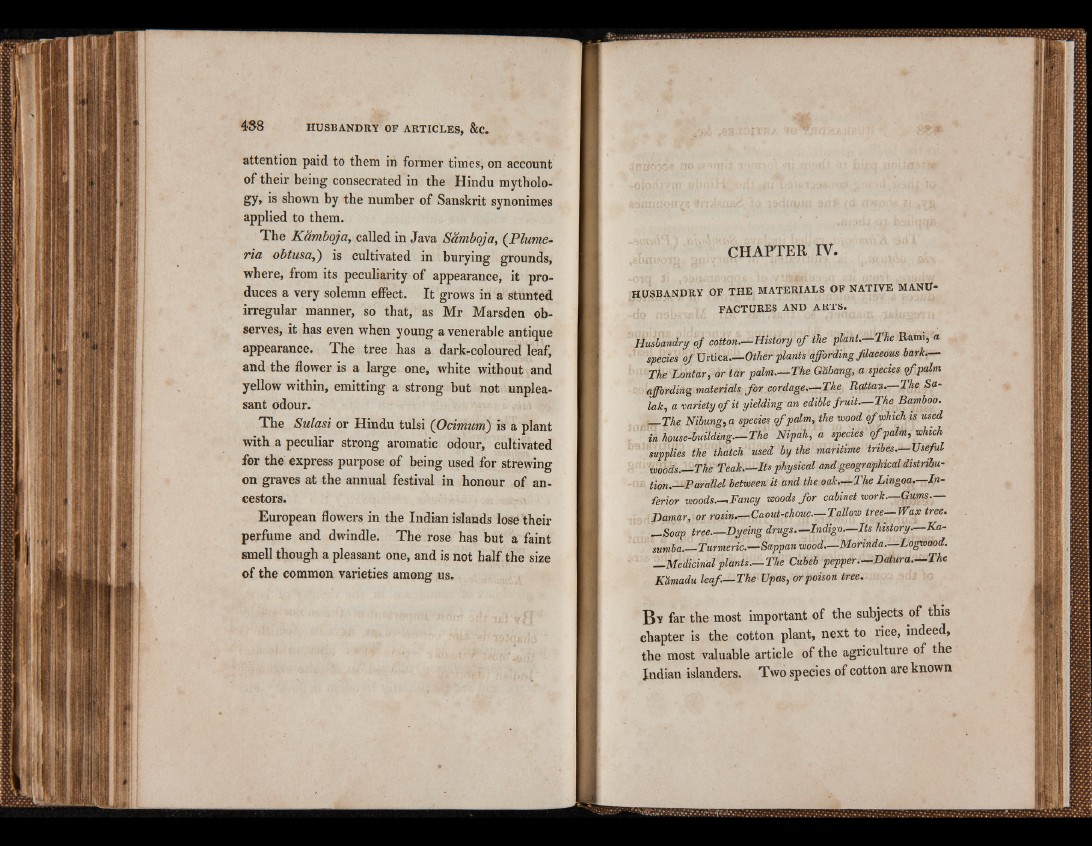
attention paid to them in former times, on account
of their being consecrated in the Hindu mythology,
is shown by the number of Sanskrit synonimes
applied to them.
The Kamboja, called in Java Samboja, ('Plume-
ria obtusa,) is cultivated in burying grounds,
where, from its peculiarity of appearance, it produces
a very solemn effect. It grows in a stunted
irregular manner, so that, as Mr Marsden observes,
it has even when young a venerable antique
appearance. The tree has a dark-coloured leaf,
and the flower is a large one, white without and
yellow within, emitting a strong but not unpleasant
odour.
The Sulasi or Hindu tulsi (Ocimum) is a plant
with a peculiar strong aromatic odour, cultivated
for the express purpose of being used for strewing
on graves at the annual festival in honour of ancestors.
European flowers in the Indian islands lose their
perfume and dwindle. The rose has but a faint
smell though a pleasant one, and is not half the size
of the common varieties among us.
CHAPTER IV.
HUSBANDRY OF THE MATERIALS OF NATIVE MANUFACTURES
AND ARTS.
Husbandry of c o t t o n .— History o f the plant.— The Rami, a
species o f Urtica.— Other plants affording filaceous bark.—
The Lontar, or tar palm.— The Gabang, a species o f palm
affording materials fo r cordage— The Rattan.— The Sa-
lak, a variety o f it yieldingan edible fru it.— The Bamboo.
The Nibung, a species o f palm, the wood o f which is used
in house-building.—The Nipah, a species o f palm, which
supplies the thatch used by the maritime tribes.— Useful
woods.— The Teak.— Its physical and geographical distnbu-
L tion.— Parallel between it and the oak.— The Lingoa.—In ferior
woods.— Fancy woods fo r cabinet work— Gums—
Damar, or rosin.—Caout-chouc.— Tallow tree— Wax tree.
—Soap tree.— Dyeing drugs.—Indigo— Its history. Ka-
sumba.— Turmeric.— Sappan wood— Morinda.—Logwood.
— Medicinal plants.— The Cubeb pepper.—Datura.— The
Kamadu leaf.— The Upas, or poison tree.
B y far the most important of the subjects of this
chapter is the cotton plant, next to rice, indeed,
the most valuable article of the agriculture of the
Indian islanders. Two species of cotton are known